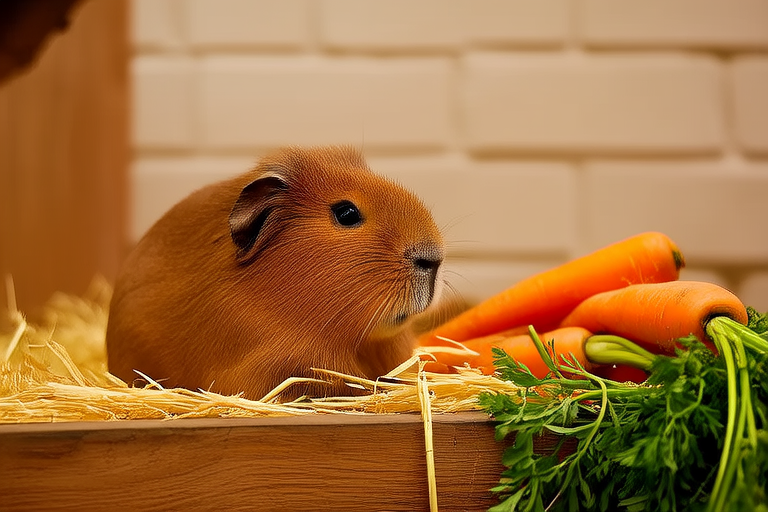How to Create the Perfect Habitat for Your Lovable Guinea Pig
Welcome to the wonderful world of guinea pigs! These charming little creatures bring joy and companionship to many homes. Creating the perfect habitat is crucial for their health and happiness. This guide will walk you through the essentials, from cage size to dietary areas, helping you build a safe and enriching environment for your furry friend.
Choosing the Right Cage Size
The first step in creating a perfect habitat is selecting the right cage. A spacious cage allows your guinea pig to move around freely, preventing stress and promoting physical health. The minimum recommended cage size for one guinea pig is 7.5 square feet (75 x 48 inches), but larger is always better. For two guinea pigs, aim for at least 10.5 square feet (48 x 60 inches). A bigger cage encourages exercise and exploration, reducing the risk of obesity and related health issues.
Selecting Bedding Materials
Choosing the right bedding is vital for your guinea pig’s comfort and hygiene. Opt for soft, absorbent materials that provide cushioning and warmth. Shredded paper, recycled paper pellets, or high-quality wood shavings are excellent choices. Avoid cedar and pine shavings, as they can irritate your guinea pig’s respiratory system. Replace bedding weekly to maintain cleanliness and prevent odors.
Proper Lighting
Guinea pigs are crepuscular animals, meaning they are most active during dawn and dusk. Providing them with a natural light cycle helps regulate their circadian rhythms. Place the cage near a window where it can receive indirect sunlight. However, avoid direct sunlight to prevent overheating. If your guinea pig lives in a room without natural light, consider using full-spectrum lighting to mimic daylight. Ensure the lighting is not too bright or harsh, as it may cause stress.
Temperature Control
Maintaining a comfortable temperature range is essential for your guinea pig’s well-being. The ideal temperature for their living space is between 65°F and 75°F (18°C to 24°C). Avoid placing the cage near drafts, windows, or air conditioning units. In colder months, provide extra bedding and consider using a heating pad placed under half of the cage to ensure they have a warm spot. In warmer months, ensure good ventilation and use a fan to keep the air circulating without blowing directly on the cage.
Hiding Spots and Enrichment
All guinea pigs need a cozy hideaway to retreat to when they feel stressed or overwhelmed. Cardboard boxes, tunnels, or small igloos make great hiding spots. These areas offer a sense of security and reduce anxiety. Additionally, providing toys for mental stimulation is crucial. Chewing toys, tunnels, and puzzle feeders encourage natural behaviors like chewing and exploring, preventing boredom and promoting mental health.
Dietary Areas
Your guinea pig’s diet area should be clean and easily accessible. Place a heavy ceramic bowl in the cage for fresh water, changing it daily to ensure cleanliness. Another bowl can hold their food, which should consist of hay, pellets, and fresh vegetables. Hay is particularly important, as it aids digestion and keeps teeth healthy. Ensure there’s always plenty of hay available. Clean both bowls regularly to prevent contamination.
Maintaining Hygiene
Hygiene is key to keeping your guinea pig healthy and happy. Regular cleaning of the cage prevents the buildup of bacteria and ammonia, which can lead to respiratory problems. Spot-clean the cage daily by removing soiled bedding and waste. Perform a deep clean every week, washing all accessories and replacing bedding. Use pet-safe disinfectants and rinse thoroughly before returning items to the cage.
Ensuring Safety
A safe habitat minimizes the risk of injury and illness. Check the cage regularly for any sharp edges or potential hazards. Secure the cage to prevent accidental tipping. Avoid placing the cage near toxic plants or household chemicals. Ensure that all toys and accessories are non-toxic and free from small parts that could be swallowed. Supervise your guinea pig when introducing new items to the cage.
The Importance of Each Component
Each element of your guinea pig’s habitat plays a crucial role in their overall health and happiness:
- Cage Size: A spacious cage allows for exercise and reduces stress.
- Bedding: Soft, absorbent bedding provides comfort and absorbs waste.
- Lighting: Natural or simulated light cycles help regulate circadian rhythms.
- Temperature Control: Maintaining a comfortable temperature prevents heatstroke or hypothermia.
- Hiding Spots and Toys: These areas offer security and mental stimulation, preventing boredom.
- Dietary Areas: Clean, accessible food and water bowls promote healthy eating habits.
- Hygiene: Regular cleaning prevents the buildup of harmful bacteria and odors.
- Safety: Ensuring a hazard-free environment minimizes the risk of injury or poisoning.
Tips for Success
Creating the perfect habitat for your guinea pig requires attention to detail and regular maintenance. Here are some additional tips to ensure your pet thrives:
- Introduce changes gradually to minimize stress.
- Rotate toys periodically to keep your guinea pig engaged.
- Monitor your guinea pig’s behavior and adjust the habitat as needed.
- Provide a variety of textures and materials for bedding and toys.
- Keep a close eye on your guinea pig’s weight and adjust their diet accordingly.
- Consider adding a second guinea pig for companionship if you have the space.
By following these guidelines, you’ll create a loving and stimulating home for your guinea pig. Remember, a happy guinea pig is a healthy guinea pig. Enjoy the journey of caring for this delightful companion!
